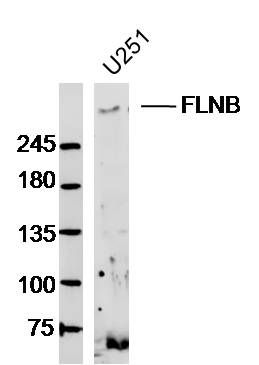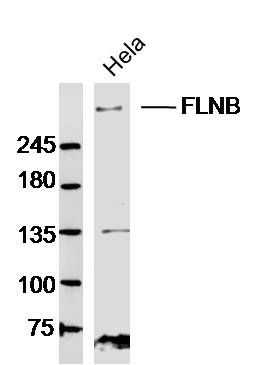This gene encodes a member of the filamin family. The encoded protein interacts with glycoprotein Ib alpha as part of the process to repair vascular injuries. The platelet glycoprotein Ib complex includes glycoprotein Ib alpha, and it binds the actin cytoskeleton. Mutations in this gene have been found in several conditions: atelosteogenesis type 1 and type 3; boomerang dysplasia; autosomal dominant Larsen syndrome; and spondylocarpotarsal synostosis syndrome. Multiple alternatively spliced transcript variants that encode different protein isoforms have been described for this gene. [provided by RefSeq, Nov 2009].
Function:
Connects cell membrane constituents to the actin cytoskeleton. May promote orthogonal branching of actin filaments and links actin filaments to membrane glycoproteins. Anchors various transmembrane proteins to the actin cytoskeleton. Interaction with FLNA may allow neuroblast migration from the ventricular zone into the cortical plate. Various interactions and localizations of isoforms affect myotube morphology and myogenesis. Isoform 6 accelerates muscle differentiation in vitro.
Subunit:
Homodimer. Isoform 1 interacts with FBLP1, FLNA, FLNC, GP1BA, INPPL1, ITGB1A, PSEN1 and PSEN2. Isoform 3 interacts with ITGB1A, ITGB1D, ITGB3 and ITGB6. Interacts with MYOT and MYOZ1. Interacts with HBV capsid protein.
Subcellular Location:
Isoform 1: Cytoplasm, cell cortex. Cytoplasm, cytoskeleton. Cytoplasm, myofibril, sarcomere, Z line. Note=In differentiating myotubes, isoform 1, isoform 2 and isoform 3 are localized diffusely throughout the cytoplasm with regions of enrichment at the longitudinal actin stress fiber. In differentiated tubes, isoform 1 is also detected within the Z-lines.
Isoform 2: Cytoplasm, cytoskeleton. Note=Predominantly localized at actin stress fibers.
Isoform 3: Cytoplasm, cytoskeleton. Note=Predominantly localized at actin stress fibers.
Isoform 6: Cytoplasm, cytoskeleton. Note=Polarized at the periphery of myotubes.
Tissue Specificity:
Ubiquitous. Isoform 1 and isoform 2 are expressed in placenta, bone marrow, brain, umbilical vein endothelial cells (HUVEC), retina and skeletal muscle. Isoform 1 is predominantly expressed in prostate, uterus, liver, thyroid, stomach, lymph node, small intestine, spleen, skeletal muscle, kidney, placenta, pancreas, heart, lung, platelets, endothelial cells, megakaryocytic and erythroleukemic cell lines. Isoform 2 is predominantly expressed in spinal cord, platelet and Daudi cells. Also expressed in thyroid adenoma, neurofibrillary tangles (NFT), senile plaques in the hippocampus and cerebral cortex in Alzheimer disease (AD). Isoform 3 and isoform 6 are expressed predominantly in lung, heart, skeletal muscle, testis, spleen, thymus and leukocytes. Isoform 4 and isoform 5 are expressed in heart.
Post-translational modifications:
ISGylation prevents ability to interact with the upstream activators of the JNK cascade and inhibits IFNA-induced JNK signaling.
DISEASE:
Note=Interaction with FLNA may compensate for dysfunctional FLNA homodimer in the periventricular nodular heterotopia (PVNH) disorder.
Defects in FLNB are the cause of atelosteogenesis type 1 (AO1) [MIM:108720]; also known as giant cell chondrodysplasia or spondylohumerofemoral hypoplasia. Atelosteogenesis are lethal short-limb skeletal dysplasias with vertebral abnormalities, disharmonious skeletal maturation, poorly modeled long bones and joint dislocations.
Defects in FLNB are the cause of atelosteogenesis type 3 (AO3) [MIM:108721]. Atelosteogenesis are short-limb lethal skeletal dysplasias with vertebral abnormalities, disharmonious skeletal maturation, poorly modeled long bones and joint dislocations. In AO3 recurrent respiratory insufficiency and/or infections usually result in early death.
Defects in FLNB are the cause of boomerang dysplasia (BOOMD) [MIM:112310]. This is a perinatal lethal osteochondrodysplasia characterized by absence or underossification of the limb bones and vertebre. Boomerang dysplasia is distinguished from atelosteogenesis on the basis of a more severe defect in mineralisation, with complete absence of ossification in some limb elements and vertebral segments.
Defects in FLNB are the cause of Larsen syndrome (LRS) [MIM:150250]. An osteochondrodysplasia characterized by large-joint dislocations and characteristic craniofacial abnormalities. The cardinal features of the condition are dislocations of the hip, knee and elbow joints, with equinovarus or equinovalgus foot deformities. Spatula-shaped fingers, most marked in the thumb, are also present. Craniofacial anomalies include hypertelorism, prominence of the forehead, a depressed nasal bridge, and a flattened midface. Cleft palate and short stature are often associated features. Spinal anomalies include scoliosis and cervical kyphosis. Hearing loss is a well-recognized complication.
Defects in FLNB are the cause of spondylocarpotarsal synostosis syndrome (SCT) [MIM:27292]; also known as spondylocarpotarsal syndrome (SCT) or congenital synspondylism or vertebral fusion with carpal coalition or congenital scoliosis with unilateral unsegmented bar. The disorder is characterized by short stature and vertebral, carpal and tarsal fusions.
Similarity:
Belongs to the filamin family.
Contains 1 actin-binding domain.
Contains 2 CH (calponin-homology) domains.
Contains 24 filamin repeats.
SWISS:
O75369
Gene ID:
2317
Database links:
Entrez Gene: 2317 Human
Entrez Gene: 286940 Mouse
Entrez Gene: 306204 Rat
Omim: 603381 Human
SwissProt: O75369 Human
SwissProt: Q80X90 Mouse
Unigene: 476448 Human
Unigene: 489652 Mouse
| Picture |
Sample:U251(Human)Cell Lysate at 40 ug
Primary: Anti-FLNB(SL13181R)at 1/300 dilution
Secondary: IRDye800CW Goat Anti-RabbitIgG at 1/20000 dilution
Predicted band size: 278kD
Observed band size: 278kD
Sample:Hela (Human)Cell Lysate at 40 ug
Primary: Anti-FLNB(SL13181R)at 1/300 dilution
Secondary: IRDye800CW Goat Anti-RabbitIgG at 1/20000 dilution
Predicted band size: 278kD
Observed band size: 278kD
|
|
|

